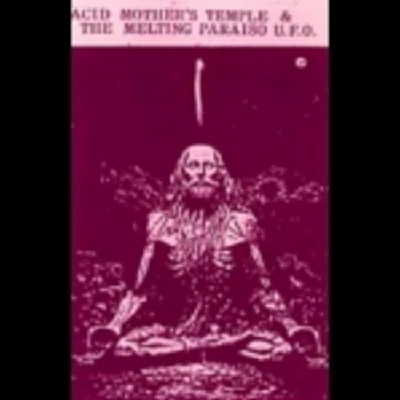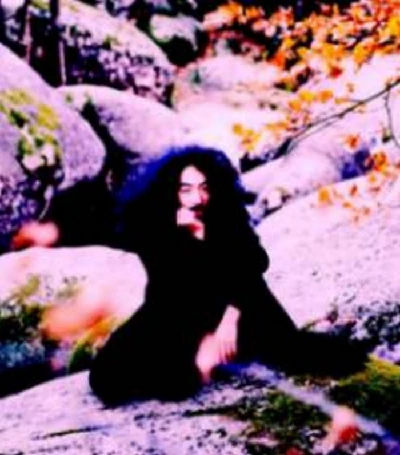Acid Mothers Temple
-
Acid Mothers Temple and the Melting Paraiso UFO
published: 23 /
6 /
2006

In our ' Re : View' slot, in which our writers reappraise albums from the past, Andrew Carver examines seminal Japanese psychedelic act Acid Mothers Temple and the Melting Paraiso UFO's 1996 eponymous debut album
Article
“What you are going to experience is ass kickin’ bud whippin’ for [sic] out drop dead cool music from another solar system when the ancient [sic] gods still ruled the Earth. This is Acid Mothers Temple and the Melting Paraiso UFO (Underground Freak Out!!)’ – from the liner notes.
Acid Mothers Temple and the Melting Paraiso UFO is almost a parody of a cult band: A semi-mystical collective led by a shaman guitarist whose music lunges from the furious to the melodic, the delicate to the comically overblown. I bought my first Acid Mothers Temple album – their self-titled CD debut - in 1999, during the dawn of my infatuation with Japanese psychedelic music.
A quick perusal of my shelves reveals another 18 Melting Paraiso albums on CD, a trio of live vinyl-only albums (including a pair of doubles) and a picture disc – good, but not complete coverage of their catalogue. I also have 15 other CDs and LPs by such related outfits as Acid Mothers Afrirampo, Acid Mothers Temple SWR, Acid Mothers Temple and the Cosmic Inferno, the Mothers of Invasion, or solo projects and collaborations.
Acid Mothers Temple leader Makoto Kawabata put the Melting Paraiso incarnation of the group on hiatus a year ago, then quickly released five albums on five different labels as Acid Mothers Temple and the Cosmic Inferno before returning to the Melting Paraiso name with ‘Have You Seen The Other Side of the Sky?’
The first album is a strange trip; its appeal rests on the ruthless extra harmonics caused by extreme distortion and the contrast wrought between the freakish and the gentle, both between songs and in the songs themselves. It was created by more than a dozen collaborators. The CD’s obi (the paper strip that runs along the side of Japanese CDs, giving its price, title and various other details) gives pride of place to Makato Kawabata, Hajime Koizumi, Hisashi Yasuda, Keizo Suhara and Cotton Casino, but the spiraling credits inside name a veritable circus of collaborators, from violinists and saxophonists right down to ‘Ichi: Dog’, whose yelping and barking can be heard on the forlorn final track.
Though it’s sequenced as one long track on CD it’s fairly easy to distinguish which of the song titles matches which music up into the last trio of songs.
The album begins in a gentle mood: There’s a short early blur of haunting voices and a scraped sarangi, the ‘Acid Mothers Prayer’.
After those first easygoing seconds, the amps go up to 11 and the band launches into a thrashing, repetitive percussion and feedback assault. The dichotomy between the two, one brief and delicate, the other lengthy and brutal, is an ongoing band motif.
The 20 minutes of alien gurgles, echoing cries and blistering amplifier torture that constitute ‘Speed Guru’ is far from the band’s longest number, but it’s certainly one of their most eardrum-shredding tunes.
Then it’s over, replaced by a bowel-deep drone – courtesy of Sakakibara Daiji’s didgeridoo – and the echoing, incomprehensible narration of Johan Wellens. Not so much a song as a breaker, ‘From the Melting Paraiso UFO I’ marks the end of the first third of the album.
A brief acoustic ditty comes next – ‘The Top Head Pixies’ is a shout out to much-admired multinational psychedelic band Gong. Kawabata would later work with Gong’s David Aellan; and the band has paid tribute in other ways.
The pastoral interlude doesn’t last long, though, and soon ‘Zen Feedbacker’ crashes out more thrashing percussion and inchoate guitar before segueing into the synthetic burbles of ‘Mach D is Bon-A-Roo’, then the wiggy female vocals and electric guitar scrapes of ‘Colouradoughnut’ where a turn of the century chanteuse warbles behind fret board anguish.
‘From the Melting Paraiso UFO II’ provides another break – more narration, more didgeridoo.
‘Amphetamine A-Go-Go’ is a more focused song – it could be a groovy soundtrack tune from a swinging 60's movie, if only those film soundtracks featured ring modulation and an onrushing wave of distortion that finally overwhelms the song. The next few numbers are harder to separate: ‘Pink Lady Lemonade’, ‘Satori LSD’, ‘Hawaiian Brownie’ – but at least one of them is another fullscale freakout, while another showcases an archetypical juxtaposition, with drifting vocals and an easygoing rhythm is subverted by electronic squiggles and feedback.
Acid Mothers Temple’s self-titled debut isn’t the band’s finest hour. ‘Univers Zen Ou de Zéro à Zéro’, their album of traditional Occitan songs, ‘La Novia’, ‘Mantra of Love’ and a few others have firmer standing in most fans’ Top 5. The production and songwriting on later albums was improved; a greater sense of restraint was also in evidence. But Acid Mother Temple’s debut set the course for a band that blended experimental composition, folk and 1970 progressive and psychedelic music, and elevated the combination to another plane.
Track Listing:-
Band Links:-
https://twitter.com/speedguru69
https://twitter.com/acidmothers
http://acidmothers.com/
https://www.facebook.com/acidmotherste
Picture Gallery:-

